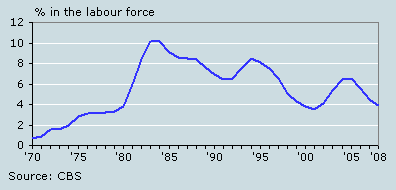Unemployment in 1930s unprecedentedly high

During the Great Depression of the 1930s, unemployment was unprecedentedly high. With 19.4 percent of the labour force unemployed, the equivalent of approximately 650 thousand labour years, unemployment reached a record level in 1935. The soaring unemployment rates were caused by a 7 percent shrink of the economy between 1929 and 1934. Exports and private sector investments plunged by 28 and 25 percent respectively.
Unemployment, 1921–1939

Highest unemployment during Great Depression in construction sector
When the crisis came to a head, nearly one third of industrial workers were unemployed. With more than half of workers unemployed, the rate was even higher in the construction sector and persisted longer. As late as in 1939, one quarter of construction workers were still unemployed. In the metal industry, more than 40 percent were unemployed, but the rate rapidly dropped to 12 percent in 1939.
Unemployment among people in regular paid employment, 1935

Highest post-war unemployment in the early 1980s
After the Second World War, a prolonged period of solid economic growth and low unemployment set in. From 1970, unemployment rose steadily but remained relatively low. All that changed during the crisis at the beginning of the 1980s.
The economy shrank between 1980 and 1982. Private sector investments and household consumption dropped by 13 and 4 percent respectively. Exports growth slowed down, but remained positive. Unemployment peaked at 10.2 percent in 1983 and 1984.
Unemployment rates in the 1980s remained far below the level of the 1930s. The increase in unemployment was more moderate in the 1980s and the period of high unemployment did not last as long as in the 1930s.
Unemployment, 1970–2008

As many men as women unemployed
After the 1980s, unemployment rates soared as a result of the poor economic situation: 8.5 percent in 1994 and 6.5 percent in 2004 and 2005, but these rates were below the level reached in 1983 and 1984. Men and women were hit equally hard by the recession, whereas in earlier periods of recession, more men than women became unemployed.
In the past eighty years, unemployment reached its highest level when the economic situation was already improving.
Gert den Bakker, Bas van den Elshout and Michiel Vergeer